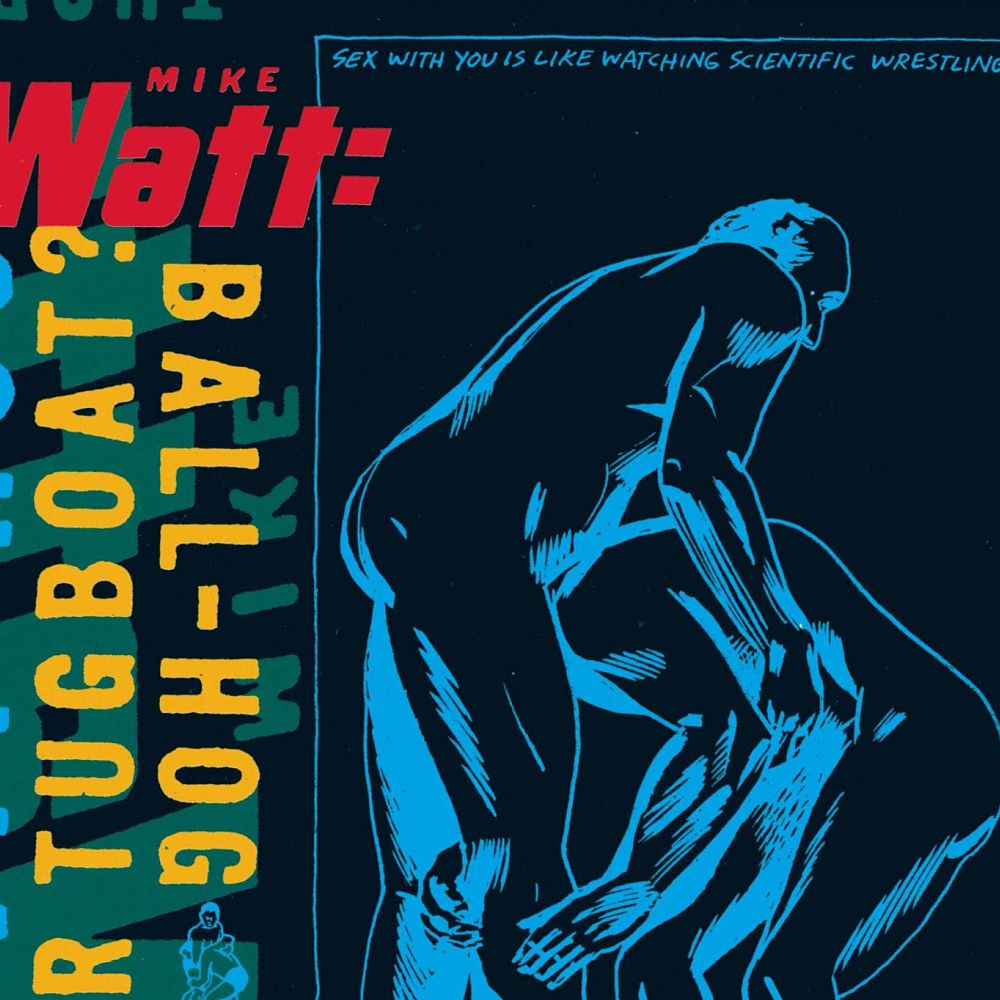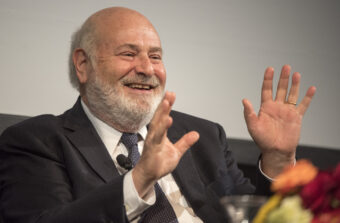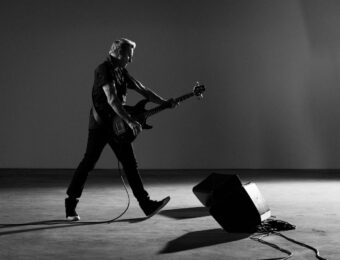A quarter-century ago, bass-blasting punk stalwart Mike Watt was at a personal and professional crossroads. At age 38, he was already a legend. For 15 years, Watt had never compromised his values. He “jammed econo,” code for nearly constant economically and ethically sustainable recording and touring. He survived the tragic death of his best friend and Minutemen bandmate D. Boon in an automobile accident in 1985. He soldiered on with George Hurley and Ed Crawford as fIREHOSE. But, by early 1994, both his marriage to former Black Flag member Kira Roessler and fIREHOSE broke up. And, for the first time in his career, Watt was on his own, a bassist without a band.
“So that year, ’94, I actually don’t tour. I think it’s the first time that happened since The Minutemen days,” Watt told SPIN.
That summer, he would craft a solution to that problem by bringing together an astonishing group of friends to create one of the most idiosyncratic albums in rock history. Inspired in part by Walt Whitman’s “Song of Myself,” Ball-Hog or Tugboat? is a kaleidoscopic autobiographical narrative and a profound meditation on the role of the bassist in popular music. The album is packed with covers. It swings wildly from punk to jazz and from pop to spoken word with the gleeful confidence of the best college radio DJ.
Ball-Hog or Tugboat features nearly 50 guest stars, collaborators from all parts of his career, including, but not limited to, members of Nirvana, Pearl Jam, Black Flag, Bikini Kill, Beastie Boys, Red Hot Chili Peppers, Soul Asylum, Dinosaur Jr., Jane’s Addiction, Germs, Pixies, Screamers, The Lemonheads, The Meat Puppets, Saccharine Trust, The Circle Jerks, Screaming Trees, that dog, The Geraldine Fibbers, Bazooka, Liquid Jesus, and Parliament-Funkadelic.
Watt refers to Ball-Hog as “The Wrestling Record” because he liked the idea of collecting a diverse group of musicians to pound it out in the studio. Each of the 17 songs was essentially made by a brand new band, all guided by Watt’s taste and bass. “You know, a bass player is kind of like glue. If you don’t have things to stick to, you’re kind of a puddle. The whole idea of solo bass players is insane,” Watt said.
That’s why he called the album Ball-Hog or Tugboat? He was asking: “Are you going to be the tugboat which helps boats dock in rough surf safely? Or are you going to be like some glory hound who shoots the fucking ball every time you get it?”
The album was recorded from May to September 1994 with sessions in Seattle, New York, and Los Angeles. “It’s hilarious. To begin with, it’s called a ‘solo record’ and there’s like 48 fucking people on it.”
That’s a lot of personnel to manage, so Watt ran a tight ship. Soul Asylum’s Dave Pirner, who contributed vocals to “Tell ‘Em, Boy!” remembers the sessions as warm and inviting.
“It was fun working with Mike and it was very professional, which I did not expect. You know, it’s like you come to the studio, and you’re booked in there for an hour or two. You sing the song. Mike cuts you a check and you’re outta there,” Pirner said, laughing. “Yeah, I mean, it was just very different than the punk rock thing that I was used to anyways. But he clearly was having a good time with it, just doing whatever he wanted to do, and just calling friends and people that, you know, I don’t know ‘this guitar player sounds good on this song. And I’m going to get this guy to do that on this song.’ And he’s just sort of putting it together as he’s going along. And that was a very creative kind of a process. It was a really cool thing.”
There was an air of constant conversation and experimentation. Musicians would meet at the studio. Watt would teach them one of his new songs or a cover. They would jam and push each other. Often the sessions went in completely unexpected directions. For example, Watt and Pearl Jam’s Eddie Vedder originally intended to cover Captain Beefheart’s “Dirty Blue Gene” from 1980’s Doc at the Radar Station but scrapped it at the last minute in favor of the excellent “Against the 70s.” According to Watt, Vedder performed his vocals in a wetsuit he found in the trash in the alley behind Cherokee Studios in Hollywood.
“Heartbeat,” one of the most controversial and often discussed pieces on the album, features a “spiel” or spoken word segment by Bikini Kill’s Kathleen Hanna where she “refuses” Watt’s offer to take part in the album, accuses an unnamed participant of rape, then in a surreal twist, demands Watt return her copy of the Annie soundtrack. It was captured on the fly on Kim Gordon and Thurston Moore’s answering machine.
Watt and Dinosaur Jr.’s J Mascis recorded an impromptu three-man cover of Parliament-Funkadelic’s “Maggot Brain” with Bernie Worrell, who played on the original, after running into him in the hallway of New York’s Baby Monster Studios. Worrell, presumably unfamiliar with Watt and Mascis, was convinced to jam once Watt offered to make him the session leader, ensuring that he’d get a double payment. Mascis’ searing guitar solo, one of the album’s undeniable highlights, was recorded in one take. Watt was elated saying he always thought J “had some sort of connect with [Parliament-Funkadelic guitarist] Eddie Hazel somehow.”
When asked if Mascis was a fan of Hazel, he replied: “Not really then, I am now.” Mascis contributed guitar parts to two additional tracks and drums to one more. When asked why he made the decision to switch instruments, he said he didn’t: “It was all Watt.”
During the sessions Watt’s friends were hanging out, meeting each other for the first time, and forging friendships of their own. “Mike Watt is psychic,” Hanna said. He “randomly” put her on the same album as Beastie Boy Adam Horovitz (aka Ad-Rock) and “now we’re together 26 years.”
Pirner brought then-girlfriend Winona Ryder to hear him sing. Ryder and Watt discussed movies, specifically her love for Veronica Lake in Preston Sturges’ 1941 comedy Sullivan’s Travels.
Wilco guitarist Nels Cline and Carla Bozulich performed on two tracks, “Drove Up From Pedro” and a cover of Sonic Youth’s “Tuff Gnarl,” but never met during the recording sessions. It was only after the album came out that they became musical and romantic partners for years.
Cline, who appears on the album more than any other musician, besides Watt, remembers: “As the record progressed, obviously, more and more local players became involved.” Drummer Michael Preussner, Saccharine Trust’s Joe Baiza, and Screamers’ Paul Roessler all came onboard. Cline chalks this up to Watt’s strength as a leader. He was “embracing the community, you know, all these people he’d seen come up, all these people who were struggling, all these people that he’d heard on the local scene, people that he heard at concert series, improvisers, they all ended up on the record.” They were “all bound together by the sort of magic and insanity that is Mike Watt, you know. It’s pretty great.”
After the recording was complete, long-time Watt collaborator Raymond Pettibon contributed the iconic artwork featuring the caption “Sex with you is like watching scientific wrestling.” The beautifully designed liner notes included a foldout poster that listed all the participants in the style of a vintage wrestling promotion. Spike Jonze made a video for the lead single and album opener, a cover of Chip and Tony Kinman’s “Big Train,’ but it featured models of Union Pacific train cars and the company threatened to sue over copyright. It was pulled from rotation on MTV and is currently very difficult to find. A second video, this time for “Piss-Bottle Man,” Watt’s urine-soaked riff on The Who’s “Pictures of Lily,” featured The Lemonheads’ Evan Dando on lead vocals.
But, when it came to touring, for the first time ever, Watt was stumped. How do you recreate the energy and power of nearly 50 collaborators? “I got a call from Dave Grohl. He was with Ed [Eddie Vedder] in Australia, I think. And he said that him and Ed were talking about wanting to play with these little bands they had.”
Those “little bands” turned out to be Hovercraft, Vedder’s project with his first wife Beth Liebling, and the first incarnation of Foo Fighters. Both Grohl and Vedder would open for Watt and then back him during his set along with Pat Smear (The Germs, Nirvana) and William Goldsmith (Sunny Day Real Estate). Promoters were instructed not to advertise Grohl or Vedder or risk cancelation of the show. But the secret got out pretty quickly. They did 31 dates total, one of which, May 6, 1995, at the Metro in Chicago, is documented in the Ring Spiel” Tour ’95 live album.
“I’m really grateful to them,” Watt said. “You know, I’d never stood in the middle like that before. I’d been the left-hand man for D. Boon, right? Then with Edward [Crawford], Edward wasn’t like D. Boon…well in some ways he was, as far as like not being afraid and the guy on stage that you could lean on. Edward was a lot like D. Boon that way. So…it was my first time not in that role.”
In the years since Ball-Hog or Tugboat? Watt has released three more stellar solo albums, circled the globe, played thousands of shows with tons of other people, including a 10-year stint as the bassist of The Stooges, all the while continuing to live and work econo as an inspiration to multiple generations of new artists.
When asked if he’d ever make another “wrestling record,” he immediately and enthusiastically confirms it, but with a new variation.
“What if I did the whole thing, with one town’s guys? Cleveland’s got a lot of rock n’ roll history,” Watt said. “What if I just picked Cleveland, and I just did a record with Cleveland guys? So, when I get some time, I’m going to do that. I’m going to go there with a batch of tunes and do it the same exact way with it. Just say, ‘You want to get in the ring with me?’”




